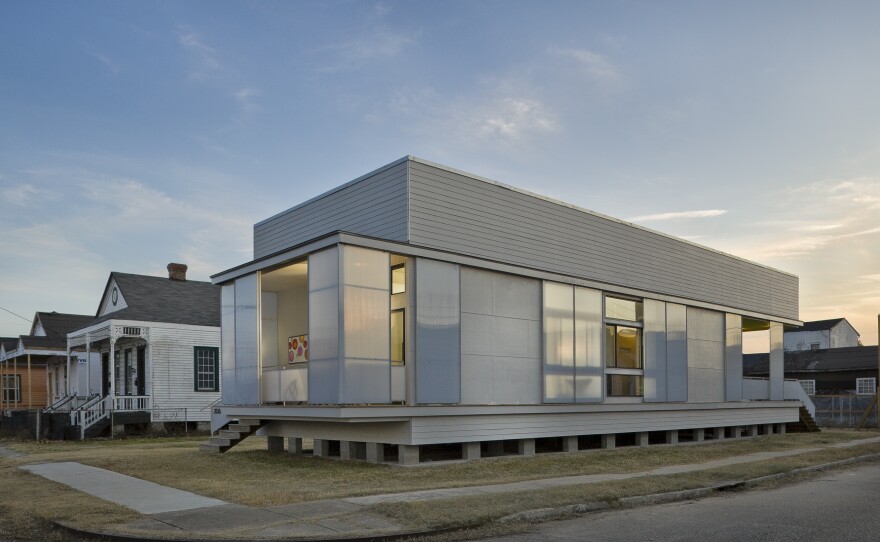It's blazingly hot outside and five summer fellows from the Tulane City Center are standing in a playground at a youth center in New Orleans. The architecture students diplomatically describe the playground's design as "unintentional": There's no grass, trees or even much shade, and it's surrounded by a chain-link fence topped with barbed wire. The students, both graduate and undergraduate, are there to make the playground a little nicer.
"Right now, it feels like a prison," says Maggie Hansen, the center's interim director.
... our students get their hands dirty. They actually get involved in real ways with real problems.
This project — one of about 10 the fellows are working on this summer — reflects a major change over the past 10 years at Tulane University's School of Architecture. The architecture program, established in 1894, is one of the country's oldest, but before Hurricane Katrina it was a little stuffy, known, if anything, for historic preservation, and not particularly prestigious. After the storm, the school reinvented itself as a destination for students and faculty interested in building in low-income neighborhoods and fragile environments.
Dean Kenneth Schwartz, who arrived at the school about seven years ago, says it's fair to describe what happened after Katrina as a pivot.
"Yeah, it certainly was," he says. "We are not the only school of architecture that cares about these issues, but our students get their hands dirty. They actually get involved in real ways with real problems."
For example, in one of the school's most popular programs, URBANbuild, students design a house in the fall semester, then build it in the spring. The final product goes to a low-income or workforce family. (The Sundance Channel featured the program in a 2008 series.)

Professor Scott Bernhard was one of the first architecture faculty members to re-examine the school's purpose and priorities after the storm. "I sort of stopped writing papers and started taking bold steps with students to build things," he recalls.
He learned that architecture students need to be taught how to work effectively in disadvantaged communities. "Students need to be given a small list of prohibitions normally," Bernhard says wryly. "They can't drive a Lexus to a community meeting in a poor neighborhood. Proposing solutions instantly to community members is a terrible problem with students who rarely see the impediments and don't understand what the problem might be in building unrealistic expectations, or solving all problems with a website that no one can afford and no one can maintain afterwards."
Since Katrina, students have helped develop more than 80 projects aimed at improving locals' lives through design. Before Katrina, and despite being the city's largest private employer, Tulane had a certain reputation in many of New Orleans' less-advantaged neighborhoods. Anthony Lee, a retired electrician who lives in the city's Algiers neighborhood, describes it as a "privileged school for privileged kids who didn't have a clue what the real world was about. Trust fund babies."

Lee's late wife was a social worker who cared about nutrition and feeding hungry kids in low-income communities. She got involved with one of Tulane City Center's most ambitious post-Katrina projects: Grow Dat Youth Farm, a vibrant urban farm that employs dozens of disadvantaged high school students. Before her death, she proposed that the center also build a community garden in her neighborhood. Lee was grieving when he heard that Tulane had accepted her proposal. "They came at a time when I needed someone to encourage me," Lee says, fighting tears. "Working with the Tulane City Center really was so helpful to me."
Now Lee manages the Magellan Street Garden, which takes up a formerly empty lot. It has a sophisticated drainage system and miniature wetlands. And he continues to be involved with the Tulane City Center; recently, Lee helped vet a round of potential projects. As a former contractor, he says it wasn't easy watching architecture students trying to build.
"A lot of these kids had never welded, used a hand tool," he says. "But it was a joy to watch. And the first thing they're learning is what? Listening."
Graduate student Ashley Ricketson chose Tulane's architecture school because she passionately cares about public interest design. The only question for her, she says, is whether to join a firm specializing in that kind of work or to bring her ethos to a more commercial practice.
"It's just important to keep people at the center of design," she says, "and actually design with people and not for people."
Copyright 2023 NPR. To see more, visit https://www.npr.org. 9(MDAzMjM2NDYzMDEyMzc1Njk5NjAxNzY3OQ001))







